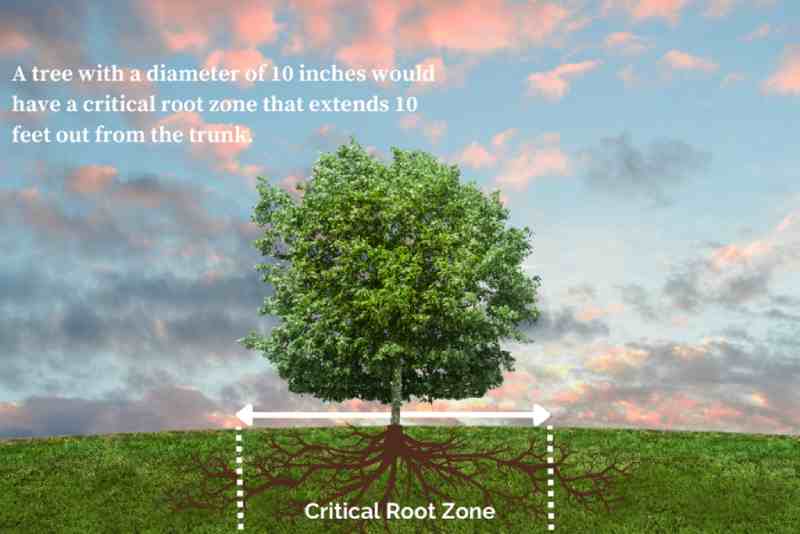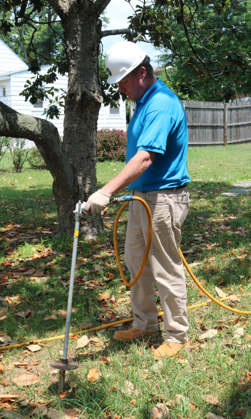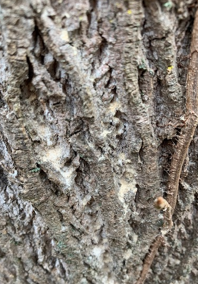Do you have big trees? Are they close to sidewalks or patios? Driveways or roadways? If so, it’s likely the ideal root zone is reduced – which is dangerous to the large tree’s livelihood. Roots are a tree’s life veins. Big trees in a limited space might have a limited Critical Root Zone (CRZ) which results in limited health. While trees typically do “self-adjust” to their environment, in special circumstances such as small spaces, they need help! If you have a big tree in a cramped space, we have the best guide for how to take care of your tree so it can stay healthy despite the odds!

Why the Critical Root Zone Matters
Much like arteries and veins do in humans, roots pass a tree the water and nutrients it needs to survive. We wouldn’t be able to survive without our blood vessels, and a tree cannot survive without its roots! A tree’s critical root zone houses the most important roots that are key to the tree’s health. Trees rely on their roots to absorb water and minerals from the ground, which it needs to survive. These roots are a tree’s foundation. If roots do not have enough space to spread out, or if they become damaged, the tree’s well-being can be severely impacted.
What is the Critical Root Zone?
The critical root zone (CRZ) refers to the area that contains a tree’s most essential roots. For every inch of a tree’s diameter, add 1 to 1.5 feet out from the tree’s trunk to get the tree’s critical root zone. So, if a tree has a diameter of 10 inches, the critical root zone would extend 10-15 feet out of the tree’s trunk. A tree’s roots do not stop at the CRZ, they extend beyond. In fact, a tree’s roots will continue to grow throughout the majority of its life.
Factors that Can Make Small Spaces Dangerous for Your Trees

So, what is it about small spaces that impact a big tree so greatly? Having less room to secure their foundation, trees in smaller spaces can be structurally unstable and susceptible to leaning or tipping.
Pictured here by one of our Certified Arborists: a big tree in a confined space. This tree doesn’t have a lot of room to grow in (especially with a pool beside it!).
Let’s look at the other factors that put stress on big trees in small spaces.
Soil Compaction
Soil compaction is known as the silent killer. In areas with heavy foot traffic or areas that underwent significant construction, the soil gradually compresses and becomes too compact for water and nutrients to pass through.
Without the crucial pore space needed for nutrient and water uptake, the tree may begin declining. This can lead to symptoms such as yellowing leaves and the presence of secondary invaders.
Nearby concrete or pool features
In-ground structures, such as pools and building foundations can significantly limit the space in which tree roots have to grow. The confined space underground can lead to girdling roots and weaken the overall health of trees. It is also important that your tree does not have any wrapping, twine, or plastic wrapped around the root ball. This can also negatively affect a tree’s health.
How to Care for Large Trees in Small Spaces
If you do have a large tree in a small space, have no fear! We have several tricks to giving your tree the best care it can get! By doing the following five things, you can provide the support and care your big trees need before it’s too late.
1. Soil Decompaction
Soil Aeration:
- Loosens the soil
- Enables new roots to grow
- Gives older roots room to breathe
- Creates pore space that mimics natural forest
- Promotes plant health and growth
Vertical mulching & soil augmentation:
- Creates holes in Critical Root Zone (CRZ)
- Replaces holes with missing organic matter
- Improves soil composition
>> Find out why soil compaction is the “Silent Killer”
2. Biostimulants

Through their 100% organic, natural blend of ingredients, root systems treated with biostimulants are able to boost overall tree health. They’re the number one thing our Certified Arborists like to recommend to clients as they support immune systems and plant development.
Biostimulants:
- Stimulate root growth
- Improve trees’ ability to fight off environmental stressors
- Provide better recovery from disease and insect damage
- Are cost-effective
>> Read more about the benefits of biostimulants
3. Proper Watering Techniques

Underwatered trees can lead to symptoms such as wilting, drooping, or yellowing leaves, tree sap, and “scorched” edges on leaves, while overwatered trees might lead to signs such as lack of growth around the base of the tree.
While we can’t control the external conditions brought by natural stressors such as weather, we can monitor plant health and adjust tree care accordingly.
Adjust Watering Technique by:
- Watering plants more during dry spells or droughts
- Watering plants less during periods of severe rain
Quick tip: To easily provide supplemental watering, you can set your garden hose to trickle for several hours.
>> Learn more about watering stressed trees
4. Preventive Borer Treatments

A common understanding is that what damage has been done can’t be fixed. Such is the case for tree borer infestations and their consequences. Trees dealing with restricted root zones are prone to borer infestations. It’s best not to wait for borers to show up, as you can’t get rid of the damage that has already been done.
Preventive Borer Treatments:
- Reduce susceptibility to borer attacks
>> Read more about destructive borers (which plague a wide variety of tree species!)
5. Proper Tree Trimming/Pruning

Although not tied to root care, a treatment list for big trees would not be complete without tree trimming. Without tree trimming, you and your family could suffer from a plethora of consequences.
Lack of tree trimming can cause big trees to crowd into powerlines, block windows, or crack foundations (to name a few). Trimming as necessary can help an overcrowding tree.
Tree trimming:
- Helps a tree maintain its ideal height
- Maintains tree structure
- Protects people and property
>> Find out why trimming your tree in the fall or winter is a smart choice


Protect Your Tree’s Long-Term Health Today
Big trees are great additions to homes. They’re beautiful and can make landscapes a little cozier. If you have big trees that you care about, it’s important to closely monitor their health. After all, if precautions aren’t taken, it can be detrimental to their livelihood – and your own.
Big, older trees deserve care. They’re like family and friends – they’ve been with us through a lot. We can provide your older trees with the proactive, rather than reactive, care that they deserve. Contact us today to meet with one of our Certified Arborists and discuss our Older Tree Care Package.



